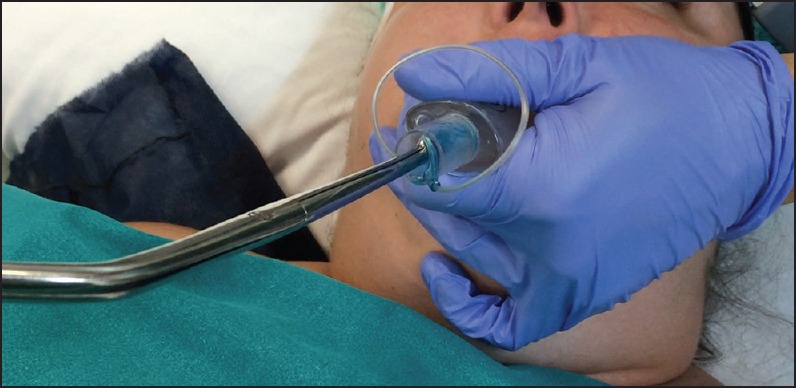Sir,
We have read with great interest the recently published paper “Nasopharyngeal airway as an aid to remove i-Gel® after endotracheal intubation through the device”[1] and we agree on the need for some specific device to hold the endotracheal tube (ETT) while i-Gel® is removed after endotracheal intubation through the device. During recent years, it seems that fibreoptic guided intubation through the i-Gel® is becoming more frequent since it's an easy and safe technique for the patient.[2] In our institution, we have been using i-Gel® since 2009. For us, this is a routinely and highly effective intubation technique, especially for expected difficult airway patients. We have tried several devices to remove i-Gel® holding the ETT in its proper position, such as nasopharyngeal cannula, another ETT on top of the ETT and even the Fastrach ® mask exchanger. However, after several years we have come to the conclusion that the most effective and safe method is using Magill forceps as an ETT holder [Figure 1]. Magill forceps were first described by Magill in 1920[3], and they are used as an aid for nasotracheal intubation as well as to remove foreign bodies.[4,5] The ease and safety they bring may be due to its easy handling, and since they are metallic, they are rigid enough to firmly hold the ETT in place.
Figure 1.

Magill forceps as an endotracheal tube (ETT) holder. Care must be taken not to damage the cuff of the ETT
Sometimes we have had some trouble in removing the i-Gel® while carrying out the procedure with nasopharyngeal cannula, and the ETT has been about to leave its proper position inside the trachea. This could be due to several causes: Improper ETT lubrication, an ETT of the maximum size allowed for the i-Gel®'s lumen, thereby causing friction, or maybe because of the cannula's material, since as it is made of plastic, it may not be rigid enough to properly hold the ETT. Perhaps, it could be a combination of all these situations. However, we haven't had any trouble in more than one hundred endotracheal intubations through the i-Gel® using Magill forceps for its removal. Of course, care should be taken when inserting the forceps to hold the ETT, since its cuff may be damaged. We, therefore, consider that Magill forceps are successful as an alternative in helping to remove i-Gel® after endotracheal intubation through the device, and we hope you can try it in your daily practice.
References
- 1.Sen I, Bhardwaj N, Latha Y. Nasopharyngeal airway as an aid to remove i-gel™ after endotracheal intubation through the device. J Anaesthesiol Clin Pharmacol. 2014;30:572–3. doi: 10.4103/0970-9185.142870. [DOI] [PMC free article] [PubMed] [Google Scholar]
- 2.Shimizu M, Yoshikawa N, Yagi Y, Tsumura Y, Kukida A, Hirakawa K, et al. Fiberoptic-guided tracheal intubation through the i-gel supraglottic airway. Masui. 2014;63:841–5. [PubMed] [Google Scholar]
- 3.Magill IW. Forceps for intratracheal anaesthesia. Br Med J. 1920;2:670. [Google Scholar]
- 4.Sakai T, Kitamura T, Iwami T, Nishiyama C, Tanigawa-Sugihara K, Hayashida S, et al. Effectiveness of prehospital Magill forceps use for out-of-hospital cardiac arrest due to foreign body airway obstruction in Osaka City. Scand J Trauma Resusc Emerg Med. 2014;22:53. doi: 10.1186/s13049-014-0053-3. [DOI] [PMC free article] [PubMed] [Google Scholar]
- 5.Sharma SK, Ahmad S, Malviya D, Nadeem S, Raghu K. Removal of sewing needle in upper oesophagus: An innovative role of Magill forceps. Indian J Anaesth. 2012;56:92–4. doi: 10.4103/0019-5049.93360. [DOI] [PMC free article] [PubMed] [Google Scholar]


